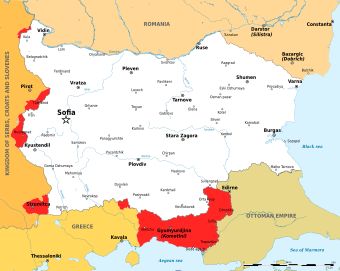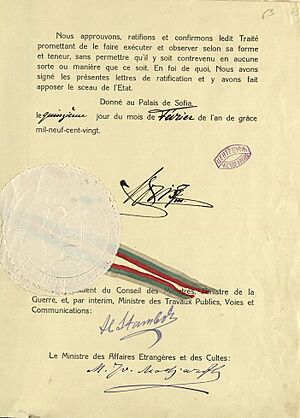Treaty of Neuilly-sur-Seine facts for kids

Bulgaria after the Treaty of Neuilly-sur-Seine
|
|
| Signed | 27 November 1919 |
|---|---|
| Location | Neuilly-sur-Seine, France |
| Condition | Ratification by Bulgaria and four Principal Allied Powers. |
| Signatories | Other Allied Powers
|
| Depositary | French Government |
| Languages | French (primary), English, Italian |
The Treaty of Neuilly-sur-Seine was an important agreement signed after World War I. It was signed on November 27, 1919, in Neuilly-sur-Seine, a town near Paris, France. This treaty was between the Allied Powers (the winners of the war) and Bulgaria, which had been one of the Central Powers (the losing side).
Because Bulgaria was on the losing side, the treaty made them give up several areas of land. It also placed limits on their military and required them to pay money to the winning countries. In Bulgaria, people often call the results of this treaty the Second National Catastrophe because it caused a lot of hardship and loss for their country.
Contents
What Did the Treaty Require?
The Treaty of Neuilly-sur-Seine made Bulgaria do several things:
- Give up Land: Bulgaria had to give up land called Western Thrace to the Allies. This land was later given to Greece, which meant Bulgaria lost its direct access to the Aegean Sea.
- Exchange People: Bulgaria had to agree to exchange populations with Greece. This meant people living in certain areas might have to move.
- More Land Ceded: Bulgaria gave up another 2,563 square kilometers of land on its western border. This land went to the Kingdom of Serbs, Croats and Slovenes, which later became Yugoslavia.
- Return Dobruja: Bulgaria had to return the region of Dobruja to Romania. This restored an older border from 1913.
- Return Property: Bulgaria had to return items or pay for things that its forces had taken from other countries during the war.
- Reduce Army: Bulgaria's army was limited to only 20,000 soldiers.
- Pay Reparations: Bulgaria had to pay £100 million in reparations. This was money paid to the winning countries for the damage caused by the war.
- Recognize New Country: Bulgaria had to officially recognize the new country called the Kingdom of Serbs, Croats and Slovenes.
The signing ceremony for this treaty took place in the town hall of Neuilly-sur-Seine.
Land Given to the Kingdom of Serbs, Croats and Slovenes
Some smaller regions, which Bulgarians call the Western Outlands, were part of Bulgaria since it became a principality in 1878. One area, around Strumitsa, joined Bulgaria in 1912. These lands were given to the Kingdom of Serbs, Croats and Slovenes in 1919.
This land transfer was partly to make up for Bulgarian troops occupying parts of southern and eastern Serbia during the war (1915-1918). It also had strategic reasons. The old border between Bulgaria and Serbia followed high mountains. The new border gave the Serbs military advantages. It made the Bulgarian capital, Sofia, more exposed and reduced the threat of a Bulgarian invasion into eastern Serbia.
The Treaty of Neuilly was one of several treaties signed after World War I. Other treaties included the Treaty of Versailles, the Treaty of Saint-Germain, the Treaty of Trianon, and the Treaty of Sèvres. All these treaties aimed to reduce the military and political power of the countries that lost the war. Some areas with mostly Bulgarian people, like Bosilegrad and part of Dimitrovgrad, were given to Serbia (part of the Kingdom of Serbs, Croats and Slovenes).
Bulgarian sources have claimed that the treaty was meant to last for twenty years, and that all the lands given away should have been returned to Bulgaria in 1939. However, this was not written in the treaty itself.
How Much Land and How Many People?

The lands that Bulgaria gave to the Kingdom of Serbs, Croats and Slovenes covered an area of 1,545 square kilometers in what is now Serbia. Another 1,028 square kilometers are in what is now North Macedonia.
In Serbia, the ceded land is in the modern Pirot District (including Dimitrovgrad) and Pčinja District (including Bosilegrad). It also includes a small area along the Timok River.
In 1919, these areas were part of different Bulgarian regions. Bulgarian records from that time claimed that 98% of the people in Bosilegrad and 95% in Tzaribrod were Bulgarian. However, a census in Yugoslavia in 1931 counted all South Slavs together, so it's hard to compare. More recently, in the 2002 census in Serbia, Bulgarians made up 50% of the population in Dimitrovgrad and 71% in Bosilegrad.
What Happened Later?
Bulgaria later got back Southern Dobruja as a result of the Treaty of Craiova. During World War II, Bulgaria, working with Nazi Germany, temporarily took back most of the other lands it had lost under the Treaty of Neuilly.
See also
- Bulgarian irredentism
- Bulgarians in North Macedonia
- Bulgarians in Serbia
- List of treaties
- Minority Treaties
- Western Outlands

